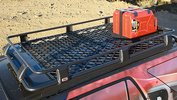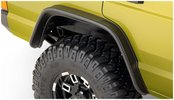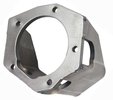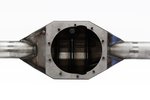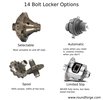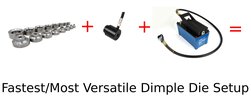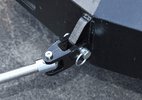A Primer on Screw and Bolt Threads

If you're looking for measuring tools start with these:
Thread Pitch Gauge: Measures thread pitches for standard and metric bolts. Doesn't really work so well for nuts.
Bolt Sizer: Measures standard and metric bolt diameters. Doesn't work for nuts.
Nut and Bolt Thread Checker: Combines the function of pitch gauge and bolt sizer into one. Works for nuts and bolts. Won't work for really large hardware over 1/2"
Is It a Bolt or a Screw?
Technically “bolt” and “screw” can actually both refer to the same piece of hardware, but the definition changes depending on it’s use. Used with a nut, it’s a bolt. When you turn it into a threaded, stationary object like an engine block, it’s a screw. For our purposes, it doesn’t really matter, but you should know that the “bolts” you buy at the hardware store might be called “cap screws” in an industrial supply catalog.
We will refer to hardware that is measured in inches as “standard”. Just remember when you’re reading: Metric = Millimeters. Standard = Inches.
Parts of a Bolt and Bolt Size Notation
First take a look at the bolt parts. You’ve got the head, unthreaded shank, and threaded shank.
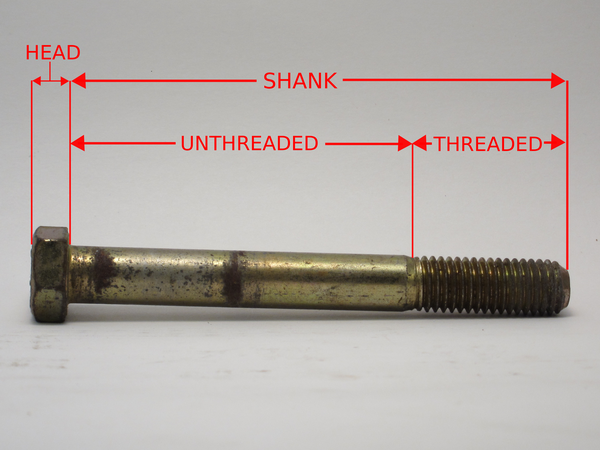
The head and shank are the main parts of a bolt. Sometimes you need to buy an extra long bolt and cut it down to get a longer unthreaded shank for things like shackle pins.
Every bolt can basically be described by diameter, thread pitch, and thread length. The notation for this in metric is:
M<diameter in mm>-<pitch in mm>x<length in mm>
So a 30mm long metric bolt or screw with a 8mm diameter and 1.25 pitch would look like:
M8-1.25x30mm
The notation for this in standard is:
<diameter in inches>-<pitch in inches>x<length in inches>
So a 2 1/2” long standard bolt or screw with a 3/8” diameter and 24 pitch would look like:
3/8-24x2 1/2”
Let’s take a look at the components and how to get the numbers we need.
Numbers and Measuring Systems
Hardware around the world (uhhh, yes, the US too...) comes in metric and standard. In the hardware store, there is one section for standard and one section for metric.
The most common metric unit for hardware is the millimeter. Thread pitch and length are typically expressed in millimeters. The most common standard unit for hardware is the inch. At the hardware store, you’d ask for a 3 inch long bolt, not a 0.25 foot long bolt. Metric hardware is always all metric and will have all of its measurements represented in metric units. There is no such thing as a 10mm diameter bolt with a 20 thread/inch pitch. Similarly, standard hardware is always all standard.
Sometimes you can determine whether a piece of hardware is metric or standard from it’s markings, but this isn’t always the case. You might need to make an educated guess. If you’re working on a Honda CBR motorcycle, you know it’s Japanese and that they use metric hardware throughout the bike. Therefore, a random bolt on the bike will be metric. If you’re working on your made-in-America Caterpillar bulldozer, you can probably assume that most of the hardware is standard.
Unfortunately, lots of cars and trucks end up with mixed hardware when components are made in different countries. You could have a Ford truck with metric-sized engine hardware and standard-sized suspension hardware. This is extremely annoying.
How to Measure Bolt Diameter
This is the diameter at the outside of the threads. If you look at the side of a bolt, this measurement goes from the thread “peaks” on the top to the thread peaks on the bottom. If someone says “5/8 inch bolt”, they’re talking about a bolt that is 5/8” from peak to peak. Metric thread diameters come in 1 millimeter increments. Standard threads come in 1/16” increments.
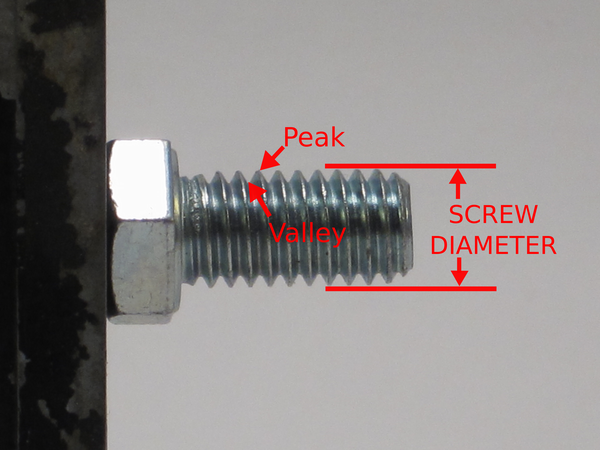
Bolt threads have peaks and valleys. Measure a bolt's diameter at the peaks.
If you’re looking at a bolt and you want to determine whether it’s standard or metric, measuring the diameter is a tricky way to do it because:
- Some metric sizes are extremely close to SAE standard sizes.
- Hardware has tolerances, which means that the 3/16” bolt you buy
probably won’t actually be exactly 3/16” at the threads - there will be
some percentage points of variance.
- Cruddy tape measure/rulers aren’t accurate. Measuring a skinny bolt on a tape measure with fat marker lines is pretty inaccurate.
- The diameter often changes along the length of the bolt. At the start of the threads the diameter will be smallest to help get the bolt started when you’re threading it. The rest of the threads are usually slightly smaller than the stated diameter. If the bolt is not fully threaded, the unthreaded part will be the thickest.
- If your hardware is coated, and it normally is for corrosion-proofing, this also adds to the diameter. This is pretty minute, but sometimes you’ll get something like a thick galvanizing coating.
The takeaway is that if you want to determine whether something is
metric or standard, the diameter is not a necessarily a good indicator unless you’re
experienced.
To determine whether a bolt is metric or standard, use a bolt diameter gauge and then check it against a pitch gauge. Don't rely solely on the diameter gauge to tell you whether it's metric or standard.
To see the variance that can occur on a high quality bolt, check out the below 5/8” coarse bolt. It is a high quality American-made piece with a well-applied thin zinc coating. Let’s measure the diameter at the tip, the threaded part of the shank, and the unthreaded part of the shank.


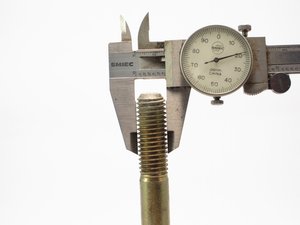
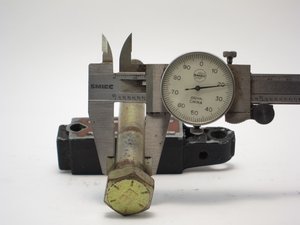
Note that 5/8” = 0.625”, but the bolt is never actually a full 0.625”. A few thousandths inch variance is pretty typical. The takeaway here is really that all things are manufactured within some tolerance. High quality hardware has lower tolerances which means that your nut and bolt combo can provide predictable clamping force.
How to Measure Bolt Thread Pitch
Thread pitch is simply the number of threads per unit of length. In metric, this would look like 1.25 threads per millimeter; in standard this might be 16 threads per inch.
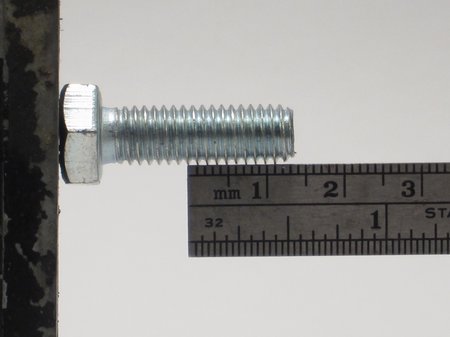
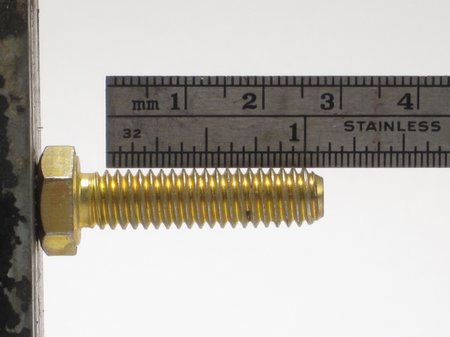
A bolt with 1.00 threads per millimeter. Count the threads at the start of the ruler until the 1 centimeter mark (this is 10 mm)- there will be 10 threads. 10 threads/10 millimeters = 1 thread/millimeter. Pitch is 1.00.
A bolt with 18 threads per inch. Count the threads at the start of the ruler until the 1 inch mark - there will be 18 threads. 18 threads/inch. Pitch is 18.
Coarse Threads and Fine Threads
Every diameter of standard and metric hardware has two standard pitches, coarse and fine. This means that your hardware store will have only 2 pitches for a 3/8” diameter bolt, 2 pitches for a 3/4” bolt, 2 pitches for a 5mm bolt, 2 pitches for a 12mm bolt, and so on. Coarse pitch, usually referred to as coarse thread is the pitch with the lower thread count. Fine pitch, or fine thread, has a higher thread count. So:
For any 3/8” coarse thread bolt, the pitch is 16.
For any 3/8” fine thread bolt, the pitch is 24.
In other words, if you want to buy a 3/8” bolt, you can get it in either coarse thread (3/8”-16) or fine thread (3/8”-24).
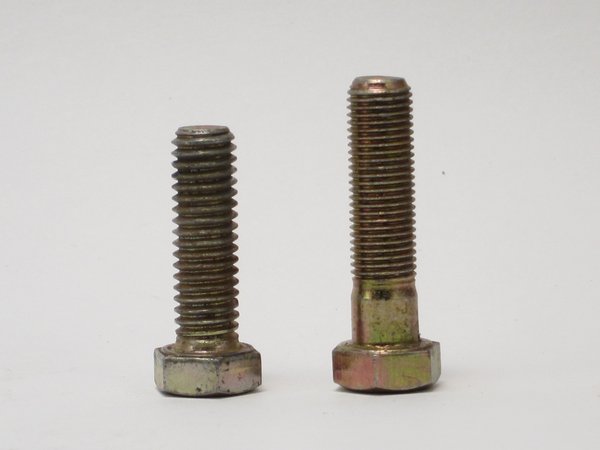
3/8" coarse on the left (3/8"-16). 3/8" fine on the right (3/8"-24). For a 3/8" diameter bolt these are the only two pitches you'll find in a hardware store.
How do I figure out a bolt's thread pitch?
You have 3 options:
1) Use another bolt. If you have another bolt or screw and you know the diameter and pitch, you can lay it on top of the unknown one. If they mesh, they have the same pitch. This is very effective and works well in the hardware store.
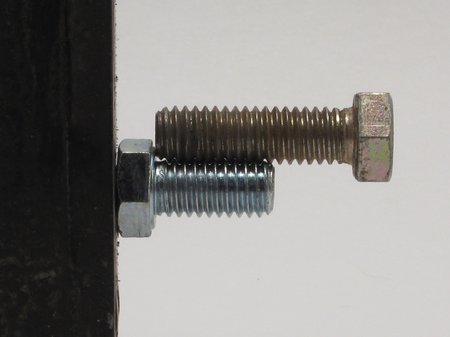
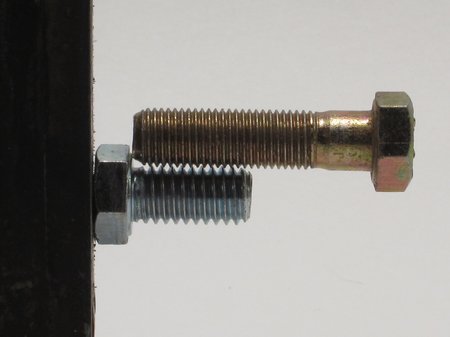
They match! These bolts mesh together PERFECTLY at the threads and have the same pitch.
They DON'T match! These bolts DO NOT mesh together, so they have different thread pitches.
2) Use a nut. If you have a nut and you know the diameter and pitch, you can try to twist it on. Sometimes, the bolt you need to replace has damaged threads and a nut won’t go on it, so this doesn’t always work.
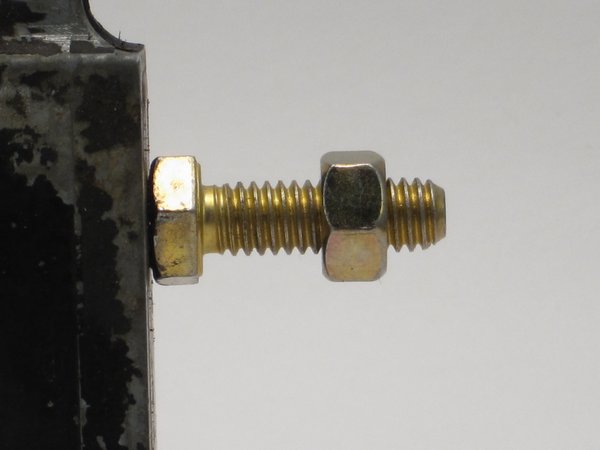
The nut is 5/16"-18, so the bolt is also 5/16"-18. If the threads are mangled or stripped, especially at the tip, you might have trouble getting the nut on.
3) Use a thread pitch gauge. You can buy these for a
few dollars. They function like the above bolt trick, but they also
have numbers printed on the gauge so that you immediately know the
pitch.
Some hardware stores have a slightly different easy-to-use thread checker hanging off their shelves - it features several bolts and
nut-like parts in popular pitch and diameter combinations. You just
need to twist on your nut or screw in your bolt to find the right pitch
and diameter. These are good because they work for bolts and nuts, but they often don't do pitches and diameters for really large hardware.
You can find pitch gauges in metric and standard:
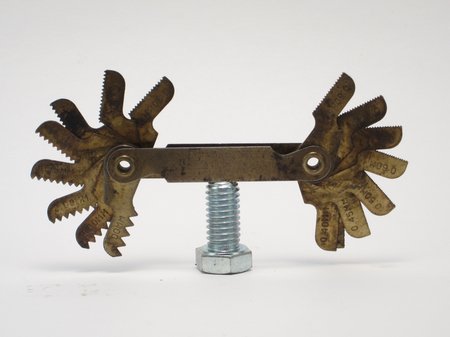
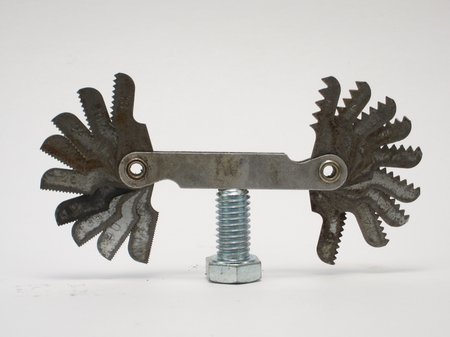
This measures threads per millimeter. Note the MM after each number.
This measures number of threads per inch.
Of the three methods, the pitch gauge is the handiest and most reliable, but the other two work fine in a pinch. Here’s the pitch gauge in action:
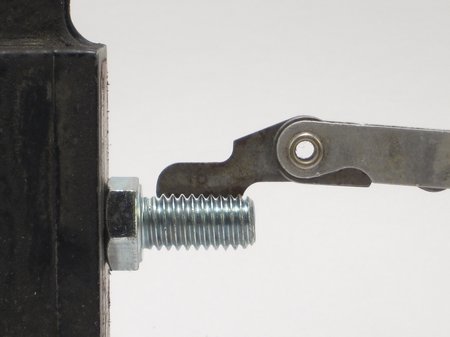
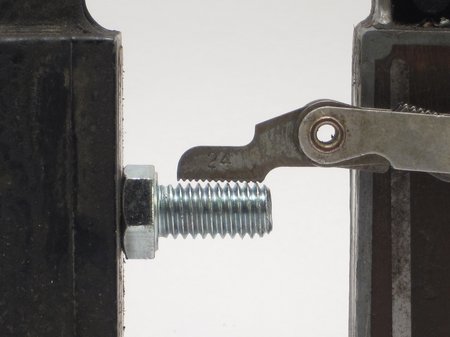
This pitch matches. This is a standard pitch gauge and the 16 matches, so we can say that this pitch is 16 threads per inch.
This pitch does NOT match. This is a standard pitch gauge, so we can say that this pitch is NOT 24 threads per inch.
Bolt Grades and Hardness
Hardware also comes rated for hardness. Basically, a higher hardness rating means the piece can take a given amount of abuse before failing. There are three categories of nut and bolt hardware hardness at your local hardware store:
- Stuff that shouldn’t go on your truck
- Harder stuff
- Good stuff
You can identify #2 and #3 in the hardware store by the markings on the head. On standard bolts, #2 and #3 will have raised radial lines: Grade 5 has 3 lines and Grade 8 has 6 lines. Grade 8 is harder.
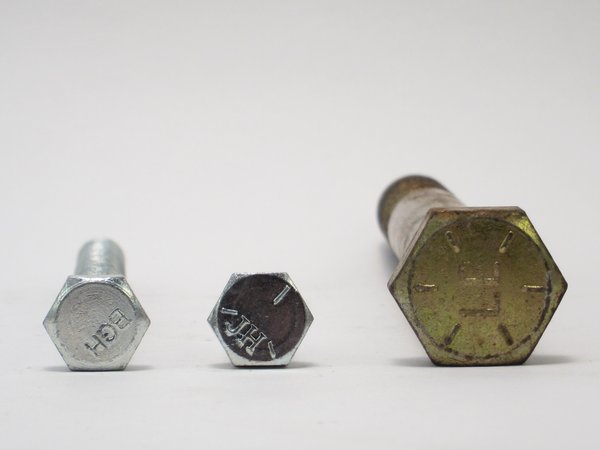
Standard bolts from left to right: an unrated bolt, a harder Grade 5 bolt (3 radial lines), an even harder Grade 8 bolt (6 radial lines). Color has nothing to do with rating, it is only a finish type.
Metric bolts use a number system. The mark “8.8” is like standard’s Grade 5. The mark “10.8” is like standard’s Grade 8.
The cheapest hardware (leftmost in the above photo) is unrated or rated at the lowest hardness. Sometimes this stuff is unmarked on the head.
So what bolt grade should you use?
Number one in the above list is low grade stuff. You could use it for holding on trim panels perhaps, or maybe you use it for a lightweight shop cart. In a vehicle that is subject to vibration and impact (aka all vehicles), this hardware will break if you stick it in critical locations. If you try to bolt on your alternator with a low grade bolt, you’ll probably end up with a sheared bolt stuck in your engine block or head. If you bolt in your leaf springs with unmarked hardware, you’ll end up being towed. Unmarked and low-grade hardware is weak and unsafe in critical applications that see a lot of stress and vibration.
You can use #2 (Grade 5 or 8.8) stuff in a lot of places, but if you’re buying a box of bolts, you may as well just buy Grade 8 or 10.8. Why? You will certainly want Grade 8/10.8 stuff holding your winch on, holding your suspension together, and stuff like that. Grade 8 and 10.8 will resist breaking or bending from forces that would break or bend Grade 5/8.8 hardware. Unless you have lots of practical experience or you’re an engineer that regularly designs the strongest joints with the cheapest hardware then you may as well go with Grade 8/10.8.
The hardware store won’t always have what you need....
Sometimes you just can’t use hardware store hardware in every single application. For instance, some engines use torque-to-yield bolts to bolt the heads to the engine. These are normally replaced by new factory hardware when you pull off the head (or you can always get a hardened head stud kit…). This kind of of fastening is relatively rare though - you’ll mostly find it on an engine, not a suspension part. Chances are that if you’re doing a job that requires torque-to-yield bolts, it’ll be a more-than-one-banana job and you’ll be reading about it in a manual. Torque-to-yield hardware will almost always be a dealer or aftermarket special order item.
Two Rules for Choosing Hardware Grade
-
Make sure that you use “sets” of graded hardware. Nuts and washers also come graded. Don’t use a lesser-graded nut with a higher graded nut! At the minimum, you might find yourself stripping out the threads of the low-quality piece when you tighten things up. Mixing grades defeats the purpose of using the higher grade, so make sure everything matches. If you use a Grade 8 bolt with a Grade 1 nut, you will have a Grade 1 joint.
-
If a piece of hardware is unmarked and you don’t have the box or know where it came from, treat it as low-quality, low-rating. Most auto and motorcycle manufacturers use unmarked hardware on vehicles - that’s totally fine to use since you know the origin (You might still want to upgrade sometimes for hardware that’s known to fail). If you buy a box of Grade 8 nuts, the nuts may or may not have Grade markings. If you don’t know the history or a piece of hardware, don’t install it where a low-rated piece could fail.
How to Measure Bolt Length
The length of a bolt does NOT include the head. It only includes the threaded and unthreaded shank. Measure from under the head to the tip. Like the bolt below, some are a bit short of their advertised length.

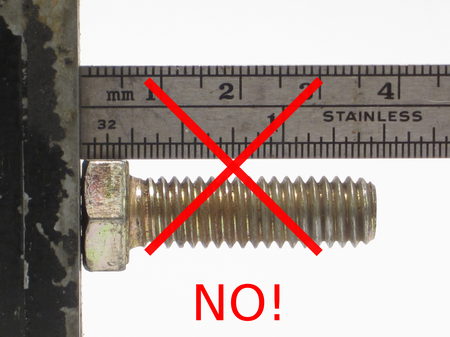
Measure from under the head to the tip. This was bought as a 1 1/4" bolt, but it's a little short!
Do not include the head. There are thin heads, heavy heads, flange heads, etc. - they are different thicknesses and are never included in length.
Where Should I Buy Hardware?
Here’s our advice: Your best sources are industrial supply stores (both local to you and online) and your local hardware stores. We’ve found that many of the larger home improvement stores and generalized department stores (places that sell toys, clothing, and hardware) sell lower quality hardware at a higher price point.
There is such a thing as counterfeit hardware, so buy from somewhere you trust. If you’re buying 1/2” bolts to attach your winch bumper, you don’t want cheap hardware on your 4x4 when you’re dangling from a cliff.
Buying in bulk is cheaper and it’s very convenient to have, say, a box of 3/8”-16x1 1/4” bolts around with another box of 3/8” nuts and washers.
Last updated: June 3, 2019
